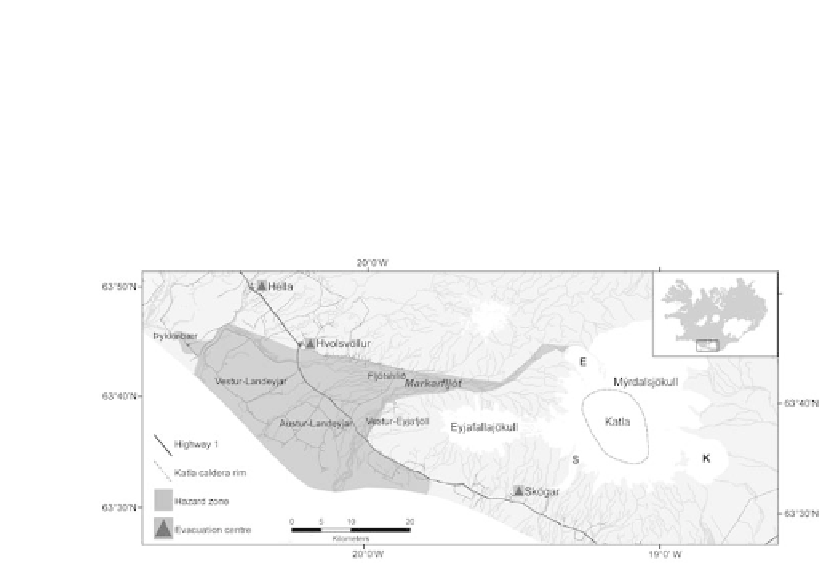Geoscience Reference
In-Depth Information
lightning strikes (Larsen, 2000) while jökulhlaup have triggered small tsunami during
past volcanic events (Guomundsson et al., 2008). Earthquakes, felt by local communities,
signify the start of an eruption. They are not however, of suffi cient magnitude to cause
major damage (Guomundsson et al., 2008). Furthermore, not all Katla eruptions have
been subglacial. Lava covered ~780 km
2
of land during the 934-938 AD Eldgjá fl ood
lava eruption which occurred along a 75 km discontinuous and predominately sub-
aerial volcanic fi ssure extending from the Katla caldera (Thordarson and Larsen, 2007).
Figure 1.
The j
ö
kulhlaup hazard zone of Rang
á
vallasysla. The hazard zone is determined to be the
maximum flood area for a catastrophic j
ö
kulhlaup. Communities located within the hazard zone
are Vestur-Eyjafj
ö
ll, Flj
ó
tshl
í
d, Austur and Vestur-Landeyjar, and Pykkvib
æ
r. Evacuation centers are
located in Hella, Hvolsv
ö
llur, and Skógar. The three catchment areas of Myrdalsj
ö
kull: Entuj
ö
kull,
Sólheimaj
ö
kull, and K
ö
tluj
ö
kull are represented by E, S and K respectively.
Since settlement in the 9th century Katla has erupted approximately 1-3 times
per century (Thordarson and Larsen, 2007). At least 21 eruptions have occurred dur-
ing this time with the last confi rmed eruption in 1918 AD (Larsen, 2000). All historic
jökulhlaup have emanated from the catchment areas of Kötlujökull and Sólheima-
jökull while none have come from the Entujökull catchment. Unconfi rmed volcanic
activity may have created the jökulhlaup which occurred in 1955 AD and 1999 AD
from the Kötlujökull and Sólheimajökull catchments, respectively (Björnsson et al.,
2000; Guomundsson, 2005; Russell et al., 2000).
The Markarfl jót valley was subjected to volcanic jökulhlaup emanating from the
Entujökull catchment prior to settlement. A series of large, valley-fi catch prehistoric
jökulhlaup were identifi ed by Smith (2004) and Larsen et al (2005) from sedimentary
deposits within the Markarfl jót valley. Further, Smith and Haraldsson (2005) deter-
mined that the last volcanic jökulhlaup on the Markarfl jót occurred 1,200 years before
present. Other types of jökulhlaup have fl ooded the Markarfl jót in more recent times.
In 1967 AD, a rock/ice avalanche caused an outburst fl ood from the proglacial lake of
Steinsholtsjökull on the northern fl ank of Eyjafjallajökull. This fl ood transported boul-
ders measuring up to 80 m
3
5 km from the rockslide scar (Kjartansson, 1967). Lastly,
geothermal meltwater drains from subglacial lakes in small, more frequent jökulhlaup
from all three catchment areas (Björnsson et al., 2000).
















